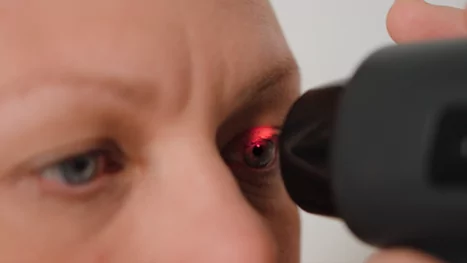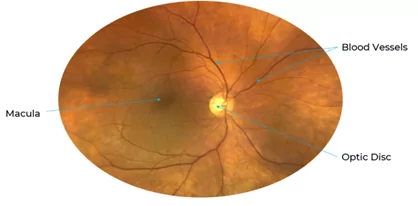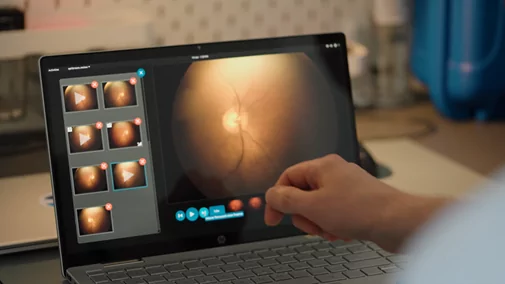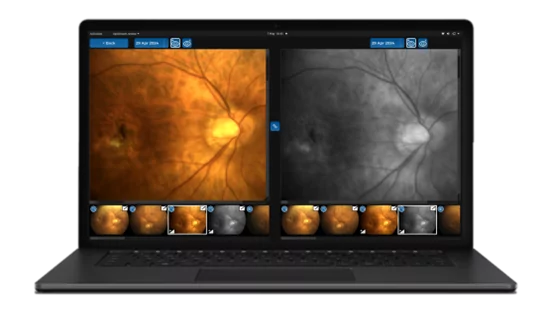What is Retinal Imaging?
Retinal imaging is a non-invasive (and non-contact), painless, diagnostic procedure used to capture detailed images of the retina; the light-sensitive layer at the back of the eye.

High resolution still and video imagery can be captured, using the right tools, which helps eye care professionals to view the intricate structures of the patient’s retina(s) – including blood vessels, the optic disc, and the macula.

The most common types of retinal imaging include fundus photography, optical coherence tomography (OCT), and fluorescein angiography:
Fundus Photography:
This involves taking high-resolution photographs of the retina using specialized cameras (such as the award winning epiCam)
Optical Coherence Tomography (OCT):
OCT provides cross-sectional images of the retina.
Fluorescein Angiography:
This technique uses a fluorescent dye to highlight the blood vessels in the retina, helping to identify abnormalities.
How Regular Retinal Imaging Can Help Protect Vision
Regular retinal imaging, as part of a comprehensive eye exam, can help in the early detection of eye diseases, which in turn can support early intervention/treatment. This can significantly reduce the risk of severe vision impairment or blindness and can help avoid complications that arise from leaving (undetected) conditions untreated.
For those already diagnosed with eye conditions, regular retinal imaging can help track the progression of the disease – This can be crucial for adjusting treatment plans and ensuring the best possible care is provided over time.

See More, Share More
Captured on a suitable device, high-quality images of the retina can be shown to the patient directly, and used to point out/highlight specific things seen during the examination, in order to help educate patients about their eye health – unlike traditional handheld ophthalmoscopes, whose analogue nature means they don’t record any of the eye exam.
Understanding the condition of their retina can help motivate patients to adhere to treatment plans and make lifestyle changes that benefit their overall eye health.
To maximize the benefits of retinal imaging, ideally it would be integrated into routine (annual) examinations in eye care practices. By encouraging patients to undergo retinal imaging as part of their regular eye exams, especially those with risk factors like diabetes, hypertension, or a family history of eye diseases, a much more detailed picture of the health of the eye, and of the individual, can be achieved.

Retinal Imaging: Good for Patients, Good for Practices
Medical practitioners who invest in the latest retinal imaging technology have a natural, competitive advantage over other healthcare providers, because they can offer more detailed insights into the retinal health of their patients.
When selecting the device(s) right for the practice, the importance of finding the right technology partner for practice imaging needs cannot be overstated.
To assist in the selection process, when considering the partner(s) to choose, the following should be considered:
Image Quality and Resolution: Ensure the technology provides high-resolution, clear images.
Reliability and Accuracy: Look for a device with proven accuracy and reliability.
User-Friendly Interface: The device should have an intuitive interface, making it easy for optometrists and staff to operate efficiently.
Portability and Footprint: Modern practices are extremely limited in terms of available space, so looking for a portable, compact imaging solution can help make the most of the space available.
Support and Training: Evaluate the company’s customer support, account management, training programs, and ongoing technical assistance to ensure smooth implementation and use.
Compliance and Certification: Ensure the device meets industry standards and regulatory certifications, such as FDA approval or CE marking.
Cost and Financing Options: Consider the total cost of ownership, including initial investment, maintenance, and potential financing options provided by the company.
Conclusion
Retinal imaging can be a powerful tool for eye care professionals, providing detailed insights into the health of the retina and enabling early detection and management of eye diseases.
By incorporating regular retinal imaging into comprehensive eye exams, it is possible to protect vision, prevent complications, and improve overall eye health.
For patients, understanding what is being seen in their eyes for themselves, helps when conveying the importance of recommended screening schedules, and can make a significant difference in preserving their vision and quality of life.
For eye care professionals, retinal imaging services can help deliver additional levels of patient care, whilst providing opportunity for additional revenue generation, from both in-practice and remote imaging services, helping them ‘See More’ patients too.
Truly a Win/Win for everyone.